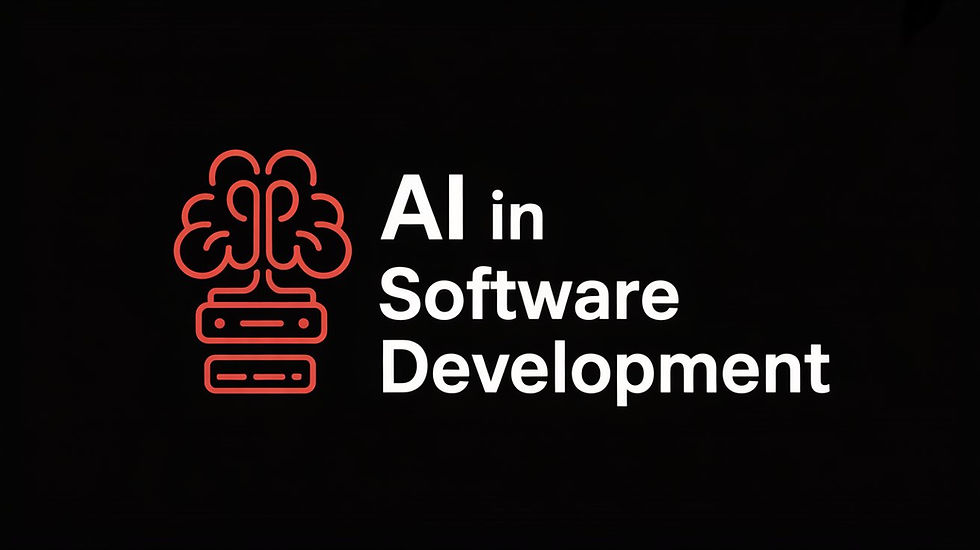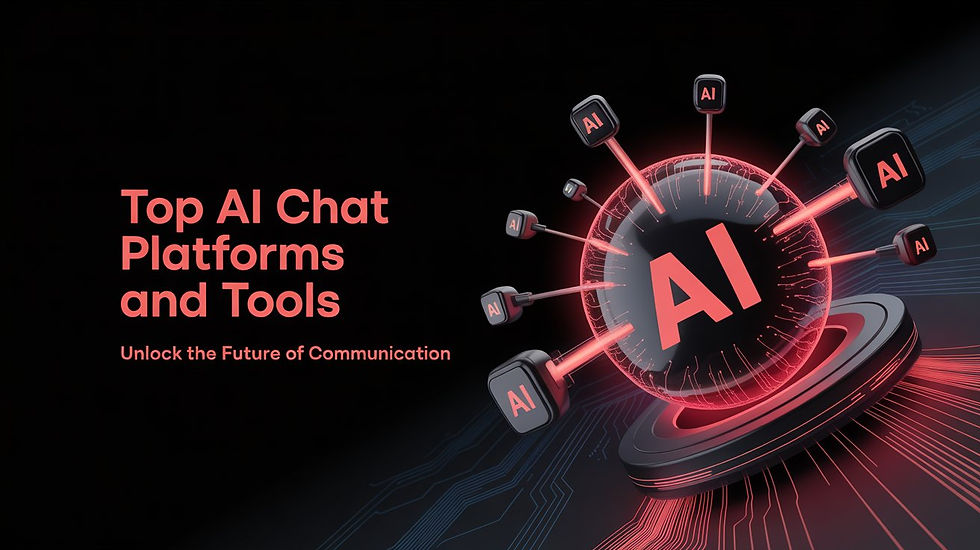AI Agents: Definition, Use Cases, and Agentic AI (2025)
- pengarhehe
- Aug 11
- 6 min read

AI Agent
AI agents are autonomous software systems that plan and execute tasks on behalf of users. They operate with a high degree of autonomy, using artificial intelligence (often large language models) to perceive the environment, make decisions, and act toward goals. For example, AWS explains that an AI agent can “collect data and use that data to perform self-directed tasks” toward a predetermined goal. Core features include reasoning, planning, memory, and adaptation: AI agents can draw conclusions, strategize next steps, store past interactions, and learn from feedback. In practice, agents often define a persona or role and are equipped with external tools or APIs to act on the world, enabling them to handle complex, multi-step problems without step-by-step instructions.
Key features of AI agents: AI agents combine several advanced capabilities. They have autonomy (operating without constant prompts) and goal-driven behavior, meaning they pursue objectives and evaluate actions to meet those goals. They exhibit reasoning and planning – using AI (e.g. LLMs or decision models) to break down goals into subtasks and devise strategies. They also include perception and learning, gathering information via text, voice, vision or data feeds, and then adapting over time by recalling past interactions. Finally, agents can collaborate with other agents or services, coordinating through a shared orchestration layer to achieve common objectives.
AI Agents vs. AI Assistants and Chatbots
AI agents differ sharply from ordinary chatbots or virtual assistants. Traditional AI assistants (like Siri or Alexa) are reactive: they wait for user commands and then carry out simple requests. In contrast, AI agents are proactive and autonomous, taking initiative toward a goal. For example, IBM uses the analogy of a movie star’s agent vs. assistant: the assistant follows orders, but the agent “is working autonomously to achieve a specific goal by any means at their disposal”. A concise summary is: Chatbots/automation follow fixed rules or respond only when prompted; AI assistants provide information or perform tasks on request; AI agents set subgoals, plan actions, and act on their own without explicit step-by-step commands. As Google Cloud notes, agents have the highest degree of autonomy (making decisions independently), whereas assistants and chatbots remain largely user-driven.
AI Agents: Proactive, goal-oriented systems that plan, act, and adapt with minimal human input.
AI Assistants: Reactive tools (chatbots or voice assistants) that respond to user prompts and suggest actions but leave decisions to the user.
Chatbots/Automation: Rule-based programs or scripts that follow pre-defined workflows and cannot adapt if conditions change.
Because AI agents continuously analyze context and can revise their plans, they far exceed traditional assistants in capability. In practice, many “agents” seen today may still rely on user prompts or scripted flows, but the ideal agentic AI is context-aware and dynamic – it “understands context, makes decisions, and takes action without you needing to spell out every step”.

How AI Agents Work
Under the hood, AI agents are typically built around large language models (LLMs) or other advanced AI models, combined with planning and memory modules. The agent’s process generally follows a loop of perceive–plan–act–learn. First, the agent perceives its environment by gathering data (e.g. reading text, accessing databases, hearing voice input). Next, it plans by using its AI core (LLMs, ML algorithms) to interpret the information and break the goal into actions. Then it acts by invoking tools or APIs – for example, querying a web API, using productivity software, or triggering a robot – to execute the plan. After acting, the agent enters a learning phase: it evaluates outcomes, reviews feedback or rewards, and updates its internal state. Over time, this continuous feedback loop allows the agent to adapt and improve.
Core components of AI agents often include:
Persona & Tools: Agents are given a defined role or identity and a set of tools (APIs, code libraries, or software services) they can use.
Planning Engine: The AI “brain” (LLM or planning algorithm) analyzes inputs and breaks goals into subtasks, formulating a strategy to accomplish them.
Action/Execution: Agents use their tools to perform complex tasks (e.g. updating a database, composing and sending an email, placing an order) to realize each step.
Memory: They maintain short-term and long-term memory of interactions. This lets them maintain context within a session and recall past information, improving coherence and personalization.
Continuous Learning: The agent refines its future behavior by learning from successes and mistakes. Techniques like reinforcement learning or self-supervised updates help the agent enhance performance over multiple iterations.
By combining these elements, AI agents effectively extend the capabilities of language models: instead of merely generating content, they use that content as part of an action plan. For instance, an agent might use an LLM to draft an email, then actually send the email via an API, then schedule follow-ups – doing everything autonomously as needed.
Applications of AI Agents
AI agents can transform many fields by automating complex, multi-step processes. For enterprises, agents are being applied wherever tasks involve decision-making and workflow orchestration. Customer Service: Agents can handle support requests end-to-end – diagnosing issues from user input, pulling relevant data from knowledge bases, and even issuing refunds or scheduling repairs autonomously. Marketing and Sales: Agents can run marketing campaigns on their own, from analyzing trends and generating content to adjusting ads and following up on leads. NVIDIA reports that agents “ingest vast amounts of customer data” to personalize marketing; an agentic marketing system could write blog posts, schedule emails, monitor engagement, and tweak strategies without manual intervention. Operations and IT: In business operations, agents automate internal workflows – e.g. a finance agent that reconciles accounts by gathering invoices, matching payments, and flagging discrepancies, or an IT agent that triages tickets by querying databases and deploying fixes. They are also used for software engineering support (generating code or automating tests) and data analysis (scraping reports, summarizing findings).
Other concrete examples include:
Travel & Personal Assistants: Planning complex itineraries by booking flights and hotels, monitoring preferences, and adjusting arrangements in real time.
Supply Chain & Logistics: Agents that re-route shipments or adapt schedules based on live data changes (something simple RPA scripts cannot handle).
Human Resources: Automating hiring processes by screening resumes, scheduling interviews, and onboarding employees.
In essence, any domain involving multi-step decision-making or complex workflows can benefit. As one IBM analysis noted, AI agents “solve complex tasks across enterprise applications, including software design, IT automation, code generation, and conversational assistance” – freeing humans to focus on higher-level strategy while the agents carry out routine to advanced tasks.

Agentic AI and Multi-Agent Systems
An important evolution of AI agents is agentic AI, where multiple autonomous agents work together. Agentic AI systems coordinate several specialized agents (each focused on a sub-task) under a central orchestration layer. For example, one agent may specialize in data extraction, another in analysis, and a third in action execution; an orchestrator assigns tasks and merges results. As one guide explains, “autonomous AI agents [are] able to plan, act, and adapt with minimal human intervention” by decomposing high-level objectives into subtasks and collaborating to achieve them. This multi-agent setup allows businesses to automate complex end-to-end processes – from customer support triage to entire marketing campaigns – far beyond what single-step chatbots or rule-based tools can do. Agentic AI optimization involves tuning these systems so every agent’s actions contribute efficiently to business goals; the goal is to align autonomy with objectives, achieving peak performance and scalability (see our What Is Agentic AI? and Agentic AI Optimization guides for more).
In practice, agentic AI means systems that adapt continuously: agents share information, learn from each other’s results, and even revise plans on the fly. For example, instead of just suggesting a keyword list, an agentic SEO system might automatically rewrite web pages, restructure site navigation, or adjust link strategies in response to live traffic data. In short, agentic AI extends generative AI into coordinated action: it can not only plan (like telling you when to climb Everest) but actually execute all steps (booking flights, handling logistics) on its own.
Top AI Programs
For readers interested in AI tools and opportunities, several AI-focused programs offer great tools and recourses. Below are some notable examples:
CustomGPT.ai (AI Chatbot Builder):
Writesonic (AI Content Generator):
Jasper.ai (AI Writing Assistant):
Synthesia (AI Video Creation):
These programs align with the agentic AI. (Chatbots, content bots, video generators) that can be components of agentic systems.
Conclusion AI Agents
In summary, AI agents represent a powerful frontier in AI: autonomous, goal-driven programs that leverage LLMs and other AI to plan and act on their own. They differ from chatbots by being proactive and often multi-faceted. The rise of agentic AI – multi-agent systems – promises to automate entire workflows across business and daily life. By understanding how AI agents work and applying them effectively (while taking advantage of related opportunities), organizations and individuals can unlock significant productivity gains.





Helpful blog on AI! I saw another related post recently that might be a good addition to this conversation. Here’s the link:https://www.linkedin.com/posts/ankitaggarwal1990_agenticai-enterpriseai-aiadoption-activity-7362204374653132800-kTLG?utm_source=share&utm_medium=member_desktop&rcm=ACoAAFtw1zsBNqN6ih-WdSak-OVptdJeF4g2IRQ